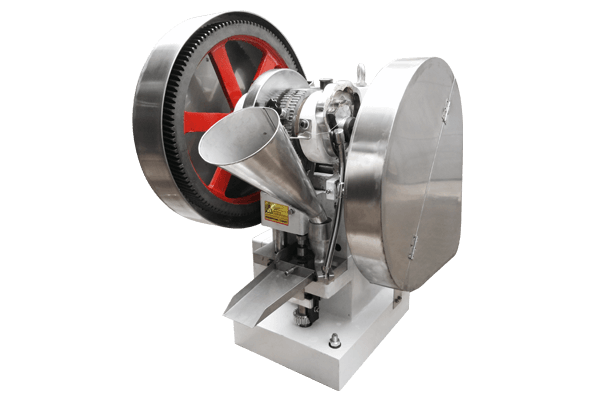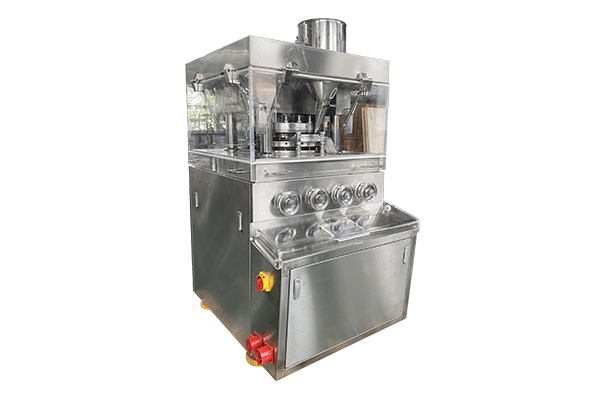What is a tablet press?
A tablet press is a device used in the manufacturing of tablets or solid pharmaceutical formulations. It is commonly employed in the pharmaceutical industry for the production of medicine. The primary function of a tablet press is to compress powdered or granular medicinal ingredients into solid tablets of defined shapes and sizes through applied pressure and the use of molds. These tablets are typically intended for oral administration, providing a convenient form for patients to take.
In the operation of a tablet press, the medicinal ingredients are fed into the press’s feeding system. Subsequently, a series of process steps, including pre-pressing, main pressing, and ejection, are carried out to produce uniform tablets with a specified hardness. The design and operation of a tablet press must consider factors such as the characteristics of the medicinal substance, the desired specifications of the tablets, and production efficiency.

Single Punch Tablet Press
A single-charging tablet press is a pharmaceutical industry device primarily designed for the production of single-layer tablets or solid formulations. In comparison to other types of tablet presses, the distinctive feature of a single-charging tablet press lies in its ability to fill the entire mold at once, forming consistently single-layer tablets.
Single Punch Tablet Press
A multi-station tablet press is a pharmaceutical device used to conduct multiple tabletting actions within a single pressing cycle, resulting in the production of multi-layered solid tablets or pills. Compared to traditional single-station presses, multi-station presses offer enhanced production efficiency and more flexible tablet manufacturing capabilities.

key components of the tablet press include
- Define the shape and size of the tablets.
- Introduces the medicinal ingredients into the tablet press.
- Provides the necessary pressure, typically through pressure rollers or rods.
- Monitors and adjusts parameters such as pressure and speed to ensure the quality and consistency of the tablets.
How does the pill press work?
The operation of a tablet press involves several key stages, including:
Feeding Stage
Medicinal ingredients in the form of powder or granules are introduced into the feeding system of the tablet press.
Pre-Compression Stage
At this stage, a certain pressure is applied to the medicinal ingredients, forming an initial compression within the mold. This step ensures uniformity and consistency of the tablets.
Main Compression Stage
In this phase, higher pressure is applied to the medicinal ingredients, shaping the final tablets within the mold. This ensures that the tablets have the desired shape and size.
Ejection Stage
The formed tablets are ejected from the mold, preparing for the next round of tablet production. This may involve vibration or other mechanical means.
Industrial Tablet Press Machines for Reliable Pill Production
Why Choose Our Tablet Press Machines?
• 30% Faster Output – Produce 5,000-20,000 tablets/hour with ≤0.5% weight variation
• Zero Downtime – Stainless steel body, German-made hydraulic system
• Plug & Play – Pre-calibrated settings for 10+ common materials (e.g., vitamin C, ibuprofen)
• Your Safety First – Auto-shutdown for overload/blockage (CE & ISO 13485 certified)
Key Features of Lanphan Tablet Press
Core Specs
✓ Max Pressure: 10-100 kN (adjustable via touchscreen)
✓ Tablet Size: 5-25 mm diameter, 1-10 mm thickness
✓ Noise Level: <65 dB
Smart Add-Ons
✓ Batch Data Export (USB/Bluetooth)
✓ Multi-layer Tablet Mode
✓ Remote Troubleshooting Port
Tablet Press Applications
Pharmaceutical
• Prescription drugs: Coated/uncoated pills, effervescent tabs
Health Supplements
• Calcium/Probiotics in tablet/capsule form
Food Industry
• Candy mints, seasoning cubes, pet food supplements
10+ Years of Customer Success
”Switched from manual to lanphan press last year. Now our Vietnam factory makes 8M vitamin tablets monthly with 2 operators.”
– James Lee, NutraHealth Malaysia
”Their engineers helped us pass FDA audit in 3 weeks.”
– Sophia R., PharmaStart Chile
